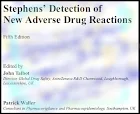Stephens' Detection of New Adverse Drug Reactions
5th Edition
Editors: John Talbot and Patrick Waller
Chapter 1. Introduction - M. D. B. Stephens (contributor)
Mercury
Introduction to pharmacovigilance
The history of pharmacovigilance
Under-reporting of adverse drug reactions
Incidence of adverse drug reactions
The financial cost of adverse drug reactions
Preventability of adverse drug reactions
Risk–benefit ratio
The changing risks with new drugs
Expression of risk
The risks we are prepared to take
Definitions
Classification of adverse drug reactions
Adverse reaction profile
Adverse events in a patient’s life
Symptoms in healthy persons
Adverse reactions to placebo
Infectiousness of adverse drug reactions
Herbal medicines
Some final food for thought
Chapter 2. Adverse Drug Reactions and Interactions: Mechanisms, Risk Factors, Detection, Management and Prevention - P. Routledge (contributor)
Introduction
Classification of adverse drug reactions
Risk factors for type A adverse reactions
Risk factors for type B adverse reactions
Detection of adverse drug reactions
Management of adverse drug reactions
Prevention of adverse drug reactions
Drug interactions
Conclusions
Chapter 3. Toxicology and Adverse Drug Reactions - D. J. Snodin (contributor)
Introduction
Toxicity testing
Drug developmen
Data interpretation and risk assessment
Adverse drug reactions detected after authorization
Examples of toxicological investigation of adverse drug reactions
Conclusions
Chapter 4. Clinical Trials: Collection of Safety Data and Establishing the Adverse Drug Reaction Profile - J.C.C. Talbot, M. D. B. Stephens (contributors)
Introduction
Adverse events
Final analysis of data
Inadequate reporting of safety data from clinical trials
Conclusions
Future aspirations
Chapter 5. Clinical Laboratory Safety Data in Drug Studies - A. Craig (contributor)
Introduction
Factors that influence interpretation of clinical laboratory data
Sample collection procedure
Analytical variation
Reference ranges
Intra-individual biological variation
Safety testing in drug development
Test selection
Exclusion criteria and ‘panic levels’
Harmonization of data from different laboratories
Data analysis and presentation
Conclusion
Chapter 6. Statistics: Analysis and Presentation of Safety Data - S. J.W. Evans (contributor)
Introduction and background
Analysis and presentation of data from trials
Measures that take time into account
Statistical tests utilizing time since start of treatment
Combining data from several trials: meta-analysis
Analysis and presentation of data from observational studies
Use of statistical methods for signal detection with spontaneous reports
Summary and conclusions
Chapter 7. Causality and Correlation in Pharmacovigilance - S. A.W. Shakir (contributors)
Introduction and historical background
The notions of necessary and sufficient causes
Factors to be considered in causality assessment
Methods for causality assessment
When to assess causality
Assessing causality from multiple information sources: the Bradford-Hill criteria
Conclusion
Chapter 8. Managing Drug Safety Issues with Marketed Products - P. C.Waller, H. H. Tilson (contributors)
Introduction
Identification of drug safety issues
Investigation
Evaluation
Action
Communicating about drug safety
Beyond communication: risk management
Managing the process
Conclusion: some thoughts on the future
Chapter 9. Regulatory Aspects of Pharmacovigilance - B. D. C. Arnold (contributor)
Introduction
Council for International Organizations of Medical Sciences
The International Conference on Harmonization
The European Union
The United Kingdom
France
Germany
United States of America
Japan
Acknowledgements
Chapter 10. Legal Aspects of Pharmacovigilance - C. Bendall (contributor)
Introduction
Legal responsibility for pharmacovigilance
Interpreting legal provisions
The relationship between European Community pharmacovigilance legislation and guidelines
National implementation
Uncertainties in European Community provisions
The potential impact of the 2001 review of pharmaceutical legislation
European powers and procedures in the event of a product safety issue
Referral to the Committee for Proprietary Medicinal Products
Failures to meet adverse drug reaction reporting requirements
Consequences of failure to meet requirements
Safety in research products
Personal data privacy
Chapter 11. Operational Aspects of the Drug Safety Function within a Pharmaceutical Company - J. Steiner (contributor)
Introduction
Overview of the case-handling process
Specifics of the case-handling process
Periodic safety updates
Staffing models for the case-handling process
Technology and the case-handling process
Quality control and the case-handling process
Training and the case-handling process
External partners and the case-handling process
Case distribution to external parties other than regulatory authorities
Conclusion: vision for the future
Acknowledgement
Chapter 12. Dictionaries and Coding in Pharmacovigilance - E. Brown (contributor)
Introduction
Scope of this chapter
Drug dictionaries
Adverse drug reaction dictionaries
Disease classifications
Combination terminology
Definition of adverse reaction terms
Conclusion
Chapter 13. Safety of Biotechnology Products - B. Brown, M. Westland (contributors)
Introduction
Properties of proteins
Categories of protein therapeutic agent
Safety monitoring for protein therapeutic agents
Off-label use
Conclusion
Chapter 14. Vaccine Safety Surveillance - E. Miller (contributor)
What is special about vaccine safety compared with other drugs?
Pathogenesis of vaccine reactions
Criteria for establishing causality for vaccine adverse events
Pre-licensure evaluation of vaccine safety
Objectives of an ideal post-licensure vaccine safety surveillance system
Passive post-licensure surveillance systems
Active surveillance of adverse vaccine events
Controlled epidemiological studies of vaccine safety
Ecological studies of vaccine safety
Conclusions
Chapter 15. Ethical Issues in Drug Safety - M. D. B. Stephens (contributor)
Introduction
Ethics in clinical trials
Ethics and the pharmaceutical industry
Conclusions
Chapter 16. A Model for the Future Conduct of Pharmacovigilance - P. C.Waller, S. J.W. Evans (contributors)
Introduction
Proposed model
Description of model components
Conclusions

-------------------------------------------------------------------------------
No comments:
Post a Comment
If you have any suggestions or find some information inaccurate, plz let me know. Thanks.